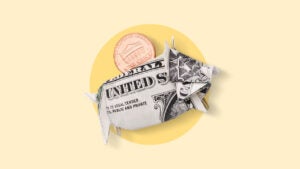Personal loan interest rate forecast for 2025: Economic uncertainty is keeping rates mostly unchanged

At its December meeting, the Fed cut rates for the second meeting in a row, bringing the new target range to 3.5-3.75%. While federal funds rate cuts usually herald falling consumer loan rates, economic uncertainty over the potential impact of President Trump’s tariff policies on inflation have dimmed the prospects for lower personal loan rates for the remainder of 2025.
Despite the disappointing Fed rate outlook, average personal loan rates are still substantially lower than average credit card rates. If you’re one of the two in five cardholders struggling with maxed-out credit cards, you may get some relief by consolidating them into one new personal debt consolidation loan.
- Average rates have dropped to 12.23% in December 2025, after ending 2024 at 12.29%.
- Average personal loan rates started at 11.93% in 2024.
- Some lenders’ starting rates have dropped below 6.5% for well-qualified borrowers.
- The lowest rates are typically offered to borrowers with credit scores over 780 for terms of three years or less.
What happened to personal loan rates in the first half of 2025?
Average personal loan rates were at 12.65% toward the middle of the year, but have recently dropped to 12.23% as of Dec. 10, 2025.
Minimum APRs for consumers with excellent credit have dropped below 6.5% with some lenders.
Homeowners with superb credit may want to consider a personal loan for home improvement to take advantage of rates that may be lower than home equity loans. However, the decision between the two loan types often depends on how much your upgrade costs.
“If you need an appliance, and you need $3,000 fast, that certainly suggests a personal loan,” former Bankrate chief financial analyst Greg McBride explains. “If you’re going to upgrade your kitchen and need $40,000 over the next six months, that’s more conducive to a home equity line of credit.”
The ease and speed of personal loans is increasing demand
The total balance of unsecured personal loans set a new record of $253 billion in the first quarter of 2025, according to recent TransUnion data. Volume has remained steady for fair- and bad-credit borrowers, with significant growth in good to excellent credit lending.
Fintech companies increased their share of personal loan origination, accounting for just over a third of the total volume in the last quarter of 2024. That may bode well for consumers with poor credit who don’t meet the stricter standards usually found at credit unions and banks.
The direction of lending standards for the rest of 2025
President Trump’s tariff policy has led to economic uncertainty, as Americans await the impact of tariff-related costs on their budgets. If the economy weakens, it may become more challenging to obtain a personal loan.
However, McBride advises against any major spending changes based on the potential effects of tariff policy. He recommends focusing more on beefing up emergency savings and paying off credit card debt as a better path to financial security.
Next steps for consumers seeking personal loans in 2025
Before you borrow, evaluate your financial goals and work on your credit scores. Borrowing with a clear purpose that supports your overall financial journey — and fits your monthly budget — will take you further than a snap decision.
Consider debt consolidation, with a caveat
With average credit card rates still significantly higher than personal loan rates, it’s easy to wonder why more people don’t choose debt consolidation loans if they have too much credit card debt. The answer may lie in spending habits and budgeting challenges.
From a credit card perspective, if money is tight, you can dial down and make a minimum payment. With a personal loan, the monthly payment is the monthly payment.— Greg McBride, CFA | Bankrate chief financial analyst
That may be too much of a strain on U.S. households struggling to cover their monthly expenses. “I think the reality of a lot of households is that most are trying to make ends meet from one month to the next, whereas debt consolidation comes more into play once you’ve solved that problem and have a handle on your expenses,” says McBride.
Improve your credit scores
“Improving your credit will do more to get you a better rate than anything the Federal Reserve does with short-term rates,” McBride explains. He also suggests that paying bills on time and paying down debt are the biggest ways to improve the rate.
But he also suggests that consumers make sure errors on their credit reports aren’t pushing down their credit scores. “Studies have shown that an eye-popping percentage of consumers have errors on their credit report,” says McBride. “Check your credit score to make sure there isn’t any inaccurate information that could be torpedoing your score.”
Why we ask for feedback Your feedback helps us improve our content and services. It takes less than a minute to complete.
Your responses are anonymous and will only be used for improving our website.








